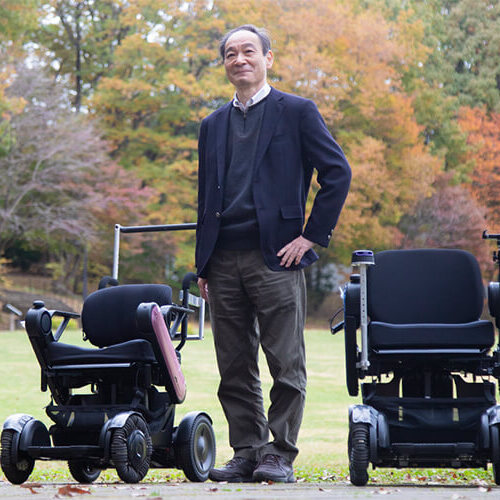Taking advantage of the experience of being involved in the development of cutting-edge autonomous driving technology as a researcher of Nissan Motor,
Hideaki Inoue is researching "autonomous driving mobility that is appreciated by the community" at Teikyo University, Professor.
Currently, the company is aiming for "mobility that allows people to walk happily without riding as much as possible" while being autonomous driving.
At first glance it seems contradictory,
There is a way of thinking about responding to social issues that has become apparent only because we are familiar with autonomous driving.
With the spread of autonomous driving
Concerns about lack of exercise

Recent advances in autonomous driving technology have been remarkable, and automatic braking, driving support functions that maintain the distance between the vehicle and the vehicle in front, and automatic driving functions under specific conditions have been realized. It is also fresh in my memory that the automatic driving bus conducted a test run at the Olympic Village of the Tokyo Olympics and Paralympics held in the summer of 2021.
If autonomous driving becomes more widespread in the future, it will become a means of transportation for people called "vulnerable people" such as the elderly living in rural areas. Even in areas where it is difficult to move without a car, it will be easier to go out and you can expect to be active. However, on the other hand, Professor Hideaki Inoue of the Department of Department of Mechanical and Precision Systems, Faculty of Science and Engineering points out that depending on the direction of autonomous driving, it may have a negative effect.
"I'm worried that older people rely too much on self-driving cars to walk, but they can't walk on their own, resulting in weakened legs. My mother has weakened legs after a broken bone, but still. I was still able to walk with a cane, but walking itself became painful and I couldn't go out. And I really couldn't walk. Autonomous driving may increase the chances of going out. However, it does not increase the chances of walking. Rather, I was concerned that it would reduce the chances of walking. "(Professor Inoue)
Professor Inoue became a Professor at Teikyo University in April 2020, and since spending time at the Utsunomiya Campus in the lush hills, he has sought to support mobility and walking for vulnerable people. It is said that he has come to feel it.

"In the vast park called" Forest of Utsunomiya Culture "near the campus, there is a beautiful walking path of beech forest. There is also a gentle slope, but wheelchairs support it, so it is such a walking for the elderly. I want you to walk on the road yourself. This is used as a demonstration field for research to achieve such a thing. "(Professor Inoue)
To support walking
Personal mobility to snuggle up to pedestrians
The target of the research is "personal mobility" for single-seaters for vulnerable people. When it comes to personal mobility for the elderly, vehicles such as carts and small cars are common, but Professor Inoue chose a commercially available electric wheelchair because "electric wheelchairs are the easiest personal mobility." Based on this electric wheelchair, we are developing a program to control it so that elderly people can ride it easily.
Originally, electric wheelchairs are "vehicles", but the electric wheelchairs studied by Professor Inoue are aimed at "walking together" rather than carrying people. If you grab it by the handlebar installed on the backrest, it will pull you when you go up the slope, and if you get tired, you can get on a wheelchair and take it home.
As for autonomous driving technology, functions such as "driving with pedestrians," "driving from behind," and "going home with the touch of a button" are envisioned. The wheelchair is equipped with a laser scanner and a camera, and keeps a distance from pedestrians and runs from behind like a pet. In addition, SLAM (Simultaneous Localization and Mapping) technology, which reads surrounding information with a laser and generates a map, allows you to move smoothly while checking your position even in the first place if there is a three-dimensional object such as indoors. ..


The current issue is a mechanism to control the electric wheelchair so that when a person walks from the front or there is an obstacle in the direction of travel, the electric wheelchair avoids the person or obstacle once and then returns to the original position. is. Complex processing is required to avoid all obstacles and get close to pedestrians. Technically, it is a problem that can be solved by applying SLAM technology and AI, but he does not want to use a method that requires as expensive a sensor as possible.
"In this research, we assume that you will drive on a fixed route such as shopping around your home, going to the hospital, taking a walk, etc. It is not always necessary to aim for perfection just because it is autonomous driving, but you can flexibly respond by lowering the automation level. I think it should be "(Professor Inoue)
Physiological and mechanical analysis of gait
Pursuing a secure interface
Professor Inoue is also working on elucidating the mechanism of walking support while advancing research on the automation of electric wheelchairs. One of them is joint research with Senior Assistant Professor Hiroaki Fujii of the Department of Judo Therapy, Faculty of Medical Technology. From a physiological point of view, we are trying to clarify how much the physical load will be reduced by pulling a person on the electric wheelchair under development. In the field of sports biomechanics, which is the specialty of Senior Assistant Professor Fujii, physical load is often evaluated by heart rate, but here as well, we are conducting research to capture the difference in the presence or absence of walking support by heart rate change.
In addition, using an experimental device with a sensor embedded in the floor, the pedaling force when walking is measured. By comparing the difference between pulling with an electric wheelchair and normal walking, we are trying to clarify why it leads to a reduction in walking load.

More recently, we have started joint research with Associate Professor Yoshito Ikemata, who studies walking robots in the Department of Mechanical and Precision Systems, Faculty of Science and Engineering. Together with Associate Professor, who studies the mechanism of walking, we created a mathematical model of walking supported by an electric wheelchair while utilizing the walking data obtained in joint research with Senior Assistant Professor Fujii, and the mechanical mechanism of walking support. I am aiming to clarify. We believe that this will lead to optimization of the shape of the handle that the pedestrian can grasp, the assist method, and improvement of safety.


"Through joint research with human body experts and gait experts, I understood that human gait is performed by an extremely efficient mechanism called" pendulum movement. "It is obvious to gait experts. It may be, but it's a very fresh discovery for me, who thought that the force of the foot kicking the ground back was enough to move forward. At university, I feel the fun of research that can pursue the truth every day. "(Professor Inoue)
From the forefront of autonomous driving research
To research that pleases the community
Inoue has worked as a researcher at Nissan Motor Co. for more than 30 years before becoming a faculty member at Teikyo University Professor 。 He has continued to conduct research at the forefront of autonomous driving technology, including current research on automatic braking and ACC (Active Cruise Control). Looking back on that time, he said that the "CEATEC JAPAN" held in 2013 was particularly impressive. Even the appearance of automobile manufacturers at CEATEC, an exhibition of home appliances and IT, caused a big buzz, but they exhibited autonomous vehicles based on electric vehicles at this exhibition hall and drove them automatically on the course set up in the venue.
"It was a time when it was thought that it was still difficult to realize autonomous driving. It showed to the world that it was possible to realize functions such as detecting the approach of other vehicles and stopping, starting, turning, avoiding parked vehicles, and stopping according to signs. I think the impact was great. "(Professor Inoue)
Following the path that we have taken along with such research on autonomous driving, we are now aiming for "technology that will please local people." First of all, we will proceed with research toward the realization of personal mobility that protects the comfort, safety and health of the elderly living around the Utsunomiya Campus.


Regarding future prospects, Professor Inoue says, "We would like to develop empirical research in collaboration with local facilities for the elderly and industry-academia collaboration with start-up companies that are considering entering welfare equipment and personal mobility." Eventually, the Utsunomiya Campus will be used as a base for tackling the problems of vulnerable people and the elderly, and from here we will propose new values for personal mobility and autonomous driving technology.





